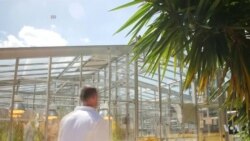ບັນດານັກວິທະຍາສາດຊາວ ອອສເຕຣເລຍ, ເຊິ່ງໄດ້ຮັບແຮງບັນ ດານໃຈ ໂດຍການ
ວິໄຈອາວະກາດຂອງອົງການ NASA ນັ້ນ, ໄດ້ ຄິດຄົ້ນ ວິທີໃໝ່ ໃນການປູກພືດທີ່ຮູ້
ຈັກກັນວ່າ “ການເພາະພັນແບບເລັ່ງລັດ”, ເຊິ່ງມີໂອກາດບົ່ມຊ້ອນຢູ່ວ່າ ຈະຊ່ອຍລ້ຽງ
ຊີບປະຊາກອນໂລກ ທີ່ກຳລັງຂະຫຽາຍຕົວອອກຢູ່ນີ້. ນັກຂ່າວວີໂອເອ ເຟທ໌ ລາປີດັສ
"Faith Lapidus" ມີລາຍງານເລື່ອງນີ້ ເຊິ່ງ ພຸດທະສອນ ຈະນຳລາຍລະອຽດມາສະ
ເໜີທ່ານໃນອັນດັບຕໍ່ໄປ.
ມັນຢູ່ຫ່າງໄກຈາກເຮືອນຂຽວຫຼັງນີ້ ໃນລັດ ຄວີນສແລນ "Queensland" ໄປຫາສະ
ຖານີອະວະກາດສາກົນ, ແຕ່ນັ້ນແມ່ນຄວາມຄິດທີ່ການປູກພືດແບບເລັ່ງລັດໄດ້ແຕກ
ງອກອອກມາ.
ທ່ານ ລີ ຮິກກີ "Lee Hickey" ນັກຄົ້ນຄວ້າຈາກມະຫາວິທະຍາໄລລັດ ຄວີນສແລນ
ໄດ້ກ່າວວ່າ “ສິ່ງທີ່ເຂົາເຈົ້າໄດ້ເຮັດ ແມ່ນໄດ້ປູກເຂົ້າຢູ່ພາຍໃຕ້ແສງໄຟທີ່ເປີດໄວ້ຢ່າງ
ຕໍ່ເນື່ອງ ດັ່ງນັ້ນພວກພືດມັນຈຶ່ງຈະບໍ່ນອນ ແລະ ມັນຫຼອກໃຫ້ພວກພືດນັ້ນໃຫຍ່ໄວ
ຫຼາຍ. ແລະ ພວກເຮົາຄິດວ່າ ອຸປະກອນນີ້ ອາດເປັນສິ່ງທີ່ຄັກ ທີ່ແທ້ຈິງແລ້ວ ຈະເລັ່ງ
ຂັ້ນຕອນໃນການຄົ້ນຄວ້າ ແລະ ການປູກພືດຢູ່ເທິງໂລກນີ້.”
ເຕັກນິກໃນການເລັ່ງປູກພືດຈະໃຊ້ດອກໄຟ LED ຢ່າງຕໍ່ເນື່ອງ ໃນໄລຍະເວລາສະ
ເພາະເຈາະຈົງ 22 ຊົ່ວໂມງຕໍ່ມື້, ເປັນການກະຕຸ້ນໃຫ້ເກີດການຈະເລີນພັນລ່ວງໜ້າ
ໃນພວກພືດຕ່າງໆ. ສິ່ງນີ້ຈະເຮັດໃຫ້ບັນດານັກວິທະຍາສາດປູກພຶດໄດ້ເຖິງ 6 ລຸ້ນ
ພາຍໃນປີດຽວ, ແທນທີ່ຈະແມ່ນລຸ້ນດຽວໃນທົ່ງນາ ຫຼື ສອງ ຫາ ສາມລຸ້ນ ໃນເຮືອນ
ຂຽວທຳມະດາ.
ທ່ານ ລີ ຮິກກີ ກ່າວວ່າ “ການໃຊ້ເຕັກນິກປູກພືດແບບເລັ່ງລັດນີ້, ພວກເຮົາສາມາດ
ເລີ່ມປູກຈາກເມັດເຂົ້າ ໃຫ້ເປັນພືດ ສຳລັບເຂົ້າເບຼ ແລະ ເຂົ້າບາຫຼີ ພາຍໃນພຽງ 6 ສັບ
ປະດາເທົ່ານັ້ນ, ແລະ ມັນກໍໄດ້ຜົນສຳລັບພວກພືດອື່ນໆ ທີ່ພວກເຮົາປູກເປັນຈຳນວນ
ຫຼາຍໃນ ອອສເຕຣເລຍ ແລະ ປະເທດອື່ນໆໃນທົ່ວໂລກຄື ໝາກຖົ່ວຂຽວ ຫຼື ເມັດ
ຄາໂນລາ ນັ້ນ.”
ສິ່ງດັ່ງກ່າວນັ້ນ ຈະເຮັດໃຫ້ການປູກພືດແບບເລັ່ງລັດ ພັດທະນາຢ່າງວ່ອງໄວ ບັນດາ
ນັກຊ່ຽວເວົ້າວ່າ ມັນເປັນທີ່ຕ້ອງການເພື່ອຂະຫຍາຍການໃຫ້ຜົນຂອງພືດ ເພື່ອຫຼໍ່ລ້ຽງ
ປະຊາກອນທີ່ກຳລັງຂະຫຍາຍຕົວຂອງໂລກ.
ທ່ານ ລີ ກ່າວວ່າ “ຈະມີການໃຫ້ອາຫານແກ່ປະຊາຊົນ 9 ພັນລ້ານຄົນ, 9 ພັນລ້ານ
ປາກພາຍໃນປີ 2050 ແລະ ພືດຂອງພວກເຮົາທີ່ເຮົາກຳລັງປູກຢູ່ທຸກມື້ນີ້ ແມ່ນບໍ່ດີພໍ
ທີ່ຈະເຮັດໃຫ້ວຽກແລ້ວ ຈຳເລັດ. ສະນັ້ນພວກເຮົາຕ້ອງການຄວາມກ້້າວໜ້າໃນດ້ານ
ພັນທຸສາດ, ພວກເຮົາຕ້ອງການທີ່ຈະສ້າງພືດພວກນີ້ໃຫ້ງອກງາມພາຍໃຕ້ອາກາດທີ່
ອຸ່ນຂຶ້ນ, ສະພາບແຫ້ງແລ້ງທີ່ປ່ຽນແປງໄດ້ຫຼາຍຂຶ້ນ ແລະ ນີ້ຍັງບໍ່ລວມເຖິງພວກສັດຕູ
ພືດ ແລະ ເຊື້ອໂຣກຕ່າງໆ.”
ບັນດານັກຄົ້ນຄວ້າ ອອສເຕຣເລຍ ໄດ້ອະທິບາຍເຕັກນິກໃນການປູກພືດແບບເລັ່ງລັດ
ຂອງເຂົາເຈົ້າໃນວາລະສານ Nature Plants, ຮ່ວມກັບບັນດານັກວິທະຍາສາດ ແລະ
ນັກປູກພືດຄົນອື່ນໆໃນທົ່ວໂລກ.
Australian scientists, inspired by NASA space experiments, have pioneered a new method of growing crops, known as "speed breeding", which has the potential to help feed the world's growing population.Faith Lapidus reports.
It is a long way from this greenhouse in Queensland to the International Space Station, but that's where the idea for speed breeding sprouted.
"What they were doing was they were growing the wheat under continuous light so the plants did not sleep and it tricked them into growing very fast. And we thought what a cool tool this might be to actually speed up our research and crop breeding here on planet earth."
The speed breeding technique uses LED lights continuously in concentrated periods of 22 hours per day, triggering early reproduction in the plants. This allows the scientists to grow up to six generations of the plants a year, instead of just one in the field or two to three in a normal greenhouse.
"Using speed breeding, we can go from seed to seed in just six weeks for wheat, barley and it works for a whole bunch of other crops that we grow on a big scale in Australia and other countries around the world like chick pea or canola."
That will allow the rapid advances in plant breeding experts say are needed to increase crop yields to feed the world's growing population.
"Nine billion people, nine billion mouths to feed by 2050 and our crops that we are growing today are not good enough to get the job done.So we need breakthroughs in genetics, we need to build these crops to be more productive under warmer climates, more variable droughts and not to mention rapidly evolving pests and pathogens."
The Australian researchers outlined their speed breeding technique in the journal Nature Plants, sharing it with scientists and plant breeders around the world.





